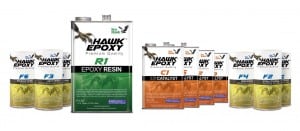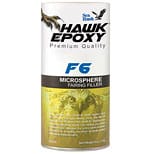Has your boat developed a blister or two? Don’t worry too much! A blister is not a serious issue. Blisters very rarely get so bad that they cannot be repaired. You can even repair them yourself!
Needed materials: Acetone, sanding block, Hawk Epoxy, acid safe disposable brushes.
 Make sure the blisters are thoroughly drained and grind them deep enough to remove any damaged material beneath the gelcoat. Increase size of ground area as needed until all the laminate around the blister is sound. Clean the entire area and allow it time to dry.
Make sure the blisters are thoroughly drained and grind them deep enough to remove any damaged material beneath the gelcoat. Increase size of ground area as needed until all the laminate around the blister is sound. Clean the entire area and allow it time to dry.
 The filler recommended for blister repair is F6 MicroSphere Fairing Filler. F6 MicroSphere Fairing Filler thickens to a white lightweight fairing compound for small to large areas.This creates an easy to sand putty that will help fill in transitions and hull imperfections. Apply using a putty knife, spatula or trowel. Spread smoothly on the surface in a 1/8″ – 1/4″ layer using heavy hand pressure to displace air bubbles/voids. Try to force the material into holes or joints and smooth to the thickness needed.
The filler recommended for blister repair is F6 MicroSphere Fairing Filler. F6 MicroSphere Fairing Filler thickens to a white lightweight fairing compound for small to large areas.This creates an easy to sand putty that will help fill in transitions and hull imperfections. Apply using a putty knife, spatula or trowel. Spread smoothly on the surface in a 1/8″ – 1/4″ layer using heavy hand pressure to displace air bubbles/voids. Try to force the material into holes or joints and smooth to the thickness needed.
Before applying the Hawk Epoxy, the hull must be very dry. Make sure the hull moisture is under 15% by using a moisture meter. Wipe down the entire area with clean rags and acetone. This will remove any remaining contaminants on the hull.
Hawk Epoxy is a low viscosity epoxy system that makes fiberglass repair easy for everyone! Equipped with a wide variety of Catalysts and fillers, you can mix up the exact epoxy batch needed for almost any job. For more information on how to mix Hawk Epoxy, click this link. Mix only enough Hawk Epoxy to use in 5-10 minutes. Apply the Hawk Epoxy to the hull using the Roll and Tip method. Use a roller to apply the epoxy and then use the tip of a high quality brush to smooth the epoxy evenly. The roller should be lint free and non-wicking. Any fibers that get in to the epoxy could compromise the integrity of the seal.
Apply the second coat when the first coat is tacky to the touch. Your finger should leave an imprint but not lift any of the epoxy coating. Allow the second coat to dry fully. Once it is completely cured, wash the repaired area with soap and water. The repair is now ready to be sanded and painted with Sea Hawk bottom paint. If redoing the hull apply Tuff Stuff primer, followed by bottom paint.
If the blister has damaged the fiberglass, that will need to be repaired with fiberglass cloth cut to match damaged area.
The video below is from Sea Hawk Paints and demonstrates how to seal a fiberglass hull using the Hawk Epoxy System.
